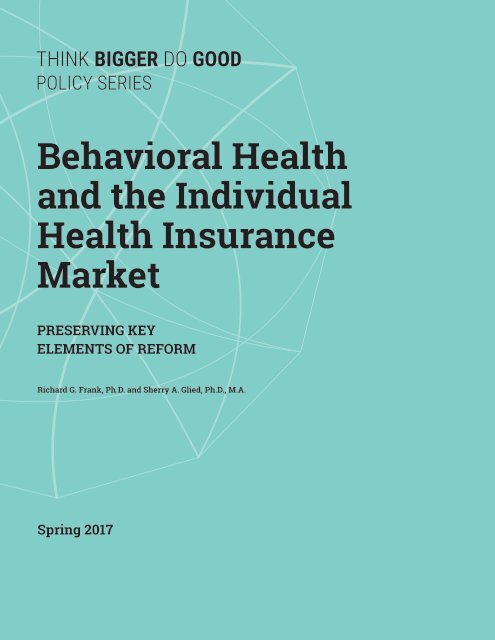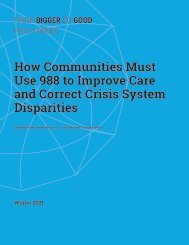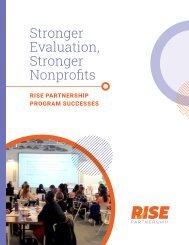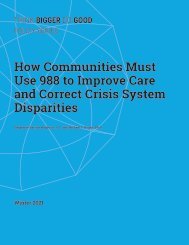Behavioral Health and the Individual Health Insurance Market
You also want an ePaper? Increase the reach of your titles
YUMPU automatically turns print PDFs into web optimized ePapers that Google loves.
THINK BIGGER DO GOOD<br />
POLICY SERIES<br />
<strong>Behavioral</strong> <strong>Health</strong><br />
<strong>and</strong> <strong>the</strong> <strong>Individual</strong><br />
<strong>Health</strong> <strong>Insurance</strong><br />
<strong>Market</strong><br />
PRESERVING KEY<br />
ELEMENTS OF REFORM<br />
Richard G. Frank, Ph.D. <strong>and</strong> Sherry A. Glied, Ph.D., M.A.<br />
Spring 2017
<strong>Behavioral</strong> <strong>Health</strong> <strong>and</strong> <strong>the</strong> <strong>Individual</strong> <strong>Health</strong> <strong>Insurance</strong> <strong>Market</strong>
Dear Reader,<br />
Now is a time of change in health <strong>and</strong> human services policy. Many of <strong>the</strong> changes could have profound<br />
implications for behavioral health. This paper is one in a series of papers focused on behavioral health<br />
policy, particularly addressing ways to continue to make progress.<br />
The past decade has been a time of steady advances in behavioral health policy. For example, we have<br />
met many of <strong>the</strong> objectives related to exp<strong>and</strong>ing health insurance coverage for people with behavioral<br />
health conditions. Coverage is now expected to be on a par with that available to individuals with any<br />
o<strong>the</strong>r health conditions, although parity implementation has encountered roadblocks. Coverage of evidencebased<br />
treatments has exp<strong>and</strong>ed with insurance, but not all of <strong>the</strong>se services are covered by traditional<br />
insurance, necessitating o<strong>the</strong>r sources of funding, such as from block grants.<br />
Much has improved; much remains to be accomplished.<br />
As funders, The Thomas Scattergood <strong>Behavioral</strong> <strong>Health</strong> Foundation <strong>and</strong> <strong>the</strong> Peg’s Foundation<br />
believe that now more than ever philanthropic support in <strong>the</strong> area of policy is critical to improving<br />
health outcomes for all. We ask that you share this paper <strong>and</strong> <strong>the</strong> o<strong>the</strong>rs in <strong>the</strong> series with your<br />
programmatic partners, local, state, <strong>and</strong> federal decision makers, advocacy organizations, <strong>and</strong> voters.<br />
We believe that <strong>the</strong>se papers analyze important issues in behavioral health policy, can inform policymaking,<br />
<strong>and</strong> improve health outcomes. We hope <strong>the</strong>se papers help to extend progress <strong>and</strong> avoid losing<br />
ground at a time of change in policy.<br />
Sincerely,<br />
Joseph Pyle, M.A.<br />
President<br />
Scattergood Foundation<br />
Founding Partner of Series<br />
Rick Kellar, M.B.A.<br />
President<br />
Peg’s Foundation<br />
Founding Partner of Series<br />
Howard Goldman, M.D., P.h.D.<br />
Series Editor
We would like to acknowledge <strong>the</strong> following individuals for <strong>the</strong>ir participation in<br />
<strong>the</strong> meeting that led to <strong>the</strong> conceptualization of <strong>the</strong> paper series.<br />
Colleen L. Barry, Ph.D., M.P.P.<br />
Bloomberg School of Public <strong>Health</strong> at<br />
John Hopkins University<br />
Cynthia Baum-Baicker, Ph.D.<br />
Thomas Scattergood <strong>Behavioral</strong><br />
<strong>Health</strong> Foundation<br />
Lisa B. Dixon, M.D., M.P.H.<br />
Columbia University College of<br />
Physicians <strong>and</strong> Surgeons,<br />
New York State Psychiatric Institute<br />
Arthur Evans, Ph.D.<br />
American Psychological Association<br />
Alyson Ferguson, M.P.H.<br />
Thomas Scattergood <strong>Behavioral</strong><br />
<strong>Health</strong> Foundation<br />
Richard G. Frank, Ph.D.<br />
Harvard Medical School<br />
Howard Goldman, M.D., Ph.D.<br />
University of Maryl<strong>and</strong> School of Medicine<br />
Pamela Greenberg, M.P.P.<br />
Association for <strong>Behavioral</strong> <strong>Health</strong><br />
<strong>and</strong> Wellness<br />
Kimberly Hoagwood, Ph.D.<br />
New York University School of Medicine<br />
Michael F. Hogan, Ph.D.<br />
Case Western Reserve University<br />
School of Medicine<br />
Chuck Ingoglia, M.S.W.<br />
National Council for <strong>Behavioral</strong> <strong>Health</strong><br />
Sarah Jones, M.D. C<strong>and</strong>idate<br />
Thomas Scattergood <strong>Behavioral</strong><br />
<strong>Health</strong> Foundation<br />
Rick Kellar, M.B.A.<br />
Peg’s Foundation<br />
Jennifer Mathis, J.D.<br />
Bazelon Center for Mental <strong>Health</strong> Law<br />
Am<strong>and</strong>a Mauri, M.P.H.<br />
Thomas Scattergood <strong>Behavioral</strong><br />
<strong>Health</strong> Foundation<br />
Mark R. Munetz, M.D.<br />
Nor<strong>the</strong>ast Ohio Medical University<br />
S<strong>and</strong>ra Newman, Ph.D.<br />
John Hopkins Bloomberg School of<br />
Public <strong>Health</strong><br />
Joe Pyle, M.A.<br />
Thomas Scattergood <strong>Behavioral</strong><br />
<strong>Health</strong> Foundation<br />
Lloyd I. Sederer. M.D.<br />
New York State Office of Mental <strong>Health</strong>,<br />
Mailman School of Public <strong>Health</strong> at<br />
Columbia University<br />
Andrew Sperling, J.D.<br />
National Alliance for Mental Illness<br />
Hyong Un, M.D.<br />
Aetna<br />
Kate Williams, J.D.<br />
Thomas Scattergood <strong>Behavioral</strong><br />
<strong>Health</strong> Foundation<br />
Glenda L. Wrenn, M.D., M.S.H.P.<br />
Satcher <strong>Health</strong> Leadership Institute at<br />
Morehouse School of Medicine<br />
<strong>Behavioral</strong> <strong>Health</strong> <strong>and</strong> <strong>the</strong> <strong>Individual</strong> <strong>Health</strong> <strong>Insurance</strong> <strong>Market</strong> 4
Titles in <strong>the</strong> Paper Series<br />
Editors Howard Goldman, M.D., Ph.D. <strong>and</strong> Constance Gartner, M.S.W.<br />
<strong>Behavioral</strong> <strong>Health</strong> <strong>and</strong> <strong>the</strong> <strong>Individual</strong> <strong>Health</strong> <strong>Insurance</strong> <strong>Market</strong>: Preserving Key<br />
Elements of Reform Richard G. Frank, Ph.D. <strong>and</strong> Sherry A. Glied, Ph.D., M.A.<br />
Coordinated Specialty Care for First-Episode Psychosis: An Example of Financing for<br />
Specialty Programs Lisa B. Dixon, M.D., M.P.H.<br />
Fentanyl <strong>and</strong> <strong>the</strong> Evolving Opioid Epidemic: What Strategies Should Policymakers<br />
Consider? Colleen L. Barry, Ph.D., M.P.P.<br />
Improving Outcomes for People with Serious Mental Illness <strong>and</strong> Co-Occurring Substance<br />
Use Disorders in Contact with <strong>the</strong> Criminal Justice System<br />
Glenda L. Wrenn, M.D., M.S.H.P., Brian McGregor, Ph.D., <strong>and</strong> Mark R. Munetz, M.D.<br />
Suicide Is a Significant <strong>Health</strong> Problem Michael F. Hogan, Ph.D.<br />
The Current Medicaid Policy Debate <strong>and</strong> Implications for <strong>Behavioral</strong> <strong>Health</strong>care in<br />
<strong>the</strong> United States Rachel Garfield, Ph.D., M.H.S. <strong>and</strong> Julia Zur, Ph.D.<br />
Find <strong>the</strong> papers online at www.thinkbiggerdogood.org
<strong>Behavioral</strong> <strong>Health</strong> <strong>and</strong> <strong>the</strong> <strong>Individual</strong> <strong>Health</strong> <strong>Insurance</strong> <strong>Market</strong> 6
<strong>Behavioral</strong> <strong>Health</strong><br />
<strong>and</strong> <strong>the</strong> <strong>Individual</strong><br />
<strong>Health</strong> <strong>Insurance</strong><br />
<strong>Market</strong><br />
PRESERVING KEY<br />
ELEMENTS OF REFORM<br />
Richard G. Frank, Ph.D.<br />
Margaret T. Morris Professor of <strong>Health</strong> Economics<br />
Harvard Medical School<br />
frank@hcp.med.harvard.edu<br />
Sherry A Glied, Ph.D., M.A.<br />
Dean, Robert F. Wagner Graduate School of Public Service<br />
New York University<br />
sg162@nyu.edu
1<br />
Introduction<br />
Since October 2008, Americans who need treatment for mental <strong>and</strong> substance use<br />
disorders have seen dramatic improvements in health insurance coverage <strong>and</strong><br />
financial security. In that month, Congress enacted <strong>and</strong> President Bush signed<br />
into law <strong>the</strong> Mental <strong>Health</strong> Parity <strong>and</strong> Addictions Equity Act (MHPAEA). A year<br />
<strong>and</strong> a half later, in March 2010, <strong>the</strong> Affordable Care Act (ACA) became law. In <strong>the</strong><br />
years since full implementation of <strong>the</strong> ACA, <strong>the</strong> availability <strong>and</strong> scope of coverage<br />
for mental <strong>and</strong> substance use disorder treatments have been fur<strong>the</strong>r enhanced<br />
through regulations. Toge<strong>the</strong>r <strong>the</strong> MHPAEA <strong>and</strong> <strong>the</strong> ACA affect coverage for well<br />
over 170 million Americans (1).<br />
The improvements have been especially significant for people with lower incomes<br />
<strong>and</strong> for those who rely on <strong>the</strong> individual <strong>and</strong> small group health insurance markets.<br />
As described below, <strong>the</strong>se markets underwent significant changes when <strong>the</strong> ACA’s<br />
insurance market regulations were implemented in 2014. Coverage changes have<br />
allowed more people to use care <strong>and</strong> have reduced <strong>the</strong> number of Americans who<br />
bear a heavy financial burden for <strong>the</strong> costs of treatment for mental or substance<br />
use disorders. In December 2016, Congress built on this foundation through enactment<br />
of <strong>the</strong> 21st Century Cures Act, which directs more funding to treatment for mental<br />
<strong>and</strong> substance use disorders. To preserve improvements in health insurance coverage,<br />
proposals to change <strong>the</strong> health insurance market should attend to <strong>the</strong> key elements<br />
of reforms established by <strong>the</strong> MHPAEA, <strong>the</strong> ACA, <strong>and</strong> <strong>the</strong> 21st Century Cures Act.<br />
In this paper, we focus on private health insurance in <strong>the</strong> individual <strong>and</strong> small group<br />
markets, where reforms have led to important gains in coverage. We address <strong>the</strong><br />
features of health insurance policy that are essential to preserve <strong>and</strong> extend <strong>the</strong><br />
progress made to date. Continued progress in exp<strong>and</strong>ing access to care through<br />
private insurance markets <strong>and</strong> creating financial protections against <strong>the</strong> costs of<br />
care for mental <strong>and</strong> substance use disorders rests on four foundational elements:<br />
coverage subsidies, insurance market regulations, m<strong>and</strong>ates on coverage <strong>and</strong> benefits,<br />
<strong>and</strong> parity <strong>and</strong> related consumer protections.<br />
These four key policy elements are interlocking. High healthcare costs in <strong>the</strong> United<br />
States, which lead to high health insurance premiums, make health insurance<br />
unaffordable for many American families—<strong>and</strong> this is particularly true for people<br />
<strong>Behavioral</strong> <strong>Health</strong> <strong>and</strong> <strong>the</strong> <strong>Individual</strong> <strong>Health</strong> <strong>Insurance</strong> <strong>Market</strong> 8
with mental <strong>and</strong> substance use disorders, who have lower average incomes <strong>and</strong><br />
incur higher treatment costs (for both general medical <strong>and</strong> behavioral healthcare)<br />
than do people without <strong>the</strong>se disorders. Without adequate subsidies, people with<br />
mental <strong>and</strong> substance use disorders will not be able to purchase coverage. At any<br />
given level of subsidy, <strong>the</strong> affordability of coverage for people with <strong>the</strong>se conditions<br />
will depend on rating rules. If insurers are permitted to underwrite coverage, exclude<br />
specific conditions, or deny coverage altoge<strong>the</strong>r, subsidies will not be sufficient to<br />
ensure financial protection. If insurers are permitted to choose which benefits to<br />
cover in <strong>the</strong>ir plans, many will choose to exclude coverage of costly treatments for<br />
mental <strong>and</strong> substance use disorders to avoid treatment costs <strong>and</strong> to discourage<br />
enrollment by people who incur <strong>the</strong>se costs. If individuals are permitted to choose<br />
to buy or forego coverage, people who do not anticipate needing services will<br />
remain outside <strong>the</strong> market. Under <strong>the</strong>se scenarios, subsidies <strong>and</strong> rating rules will<br />
enable people with mental <strong>and</strong> substance use disorders to enter <strong>the</strong> market, but<br />
<strong>the</strong> coverage that <strong>the</strong>y will be able to buy will be very costly or incomplete. Policies<br />
that create strong incentives for all eligible individuals to purchase insurance that<br />
meets specific coverage st<strong>and</strong>ards will allow a market-based system to provide<br />
coverage that includes mental <strong>and</strong> substance use disorder treatment at reasonable<br />
premiums. However, before recent reforms, insurers restricted <strong>the</strong> use of <strong>the</strong>se<br />
treatments by covering <strong>the</strong>m in ways that were not comparable to coverage for<br />
general medical conditions. Parity <strong>and</strong> o<strong>the</strong>r consumer protection rules closed those<br />
gaps, so that promised benefits are adequate.<br />
Four Foundational Elements to Exp<strong>and</strong>ing Access to<br />
Care <strong>and</strong> Creating Financial Protections:<br />
1 Coverage subsidies<br />
2 <strong>Insurance</strong> market regulations<br />
3 M<strong>and</strong>ates on coverage <strong>and</strong> benefits<br />
4 Parity <strong>and</strong> related consumer protections
2<br />
The Affordable<br />
Care Act <strong>and</strong><br />
<strong>the</strong> <strong>Individual</strong><br />
<strong>Market</strong><br />
Coverage Subsidies<br />
Before <strong>the</strong> ACA, health insurance for mental <strong>and</strong> substance use disorders offered<br />
limited protection <strong>and</strong> left cost as a barrier to treatment. In 2013, before implementation<br />
of <strong>the</strong> ACA’s coverage expansions, 44.3 million Americans under age 65 lacked health<br />
insurance (2). Of that group, 39.6 million (89%) were between <strong>the</strong> ages of 18 <strong>and</strong> 64,<br />
<strong>and</strong> about 20 million of <strong>the</strong>se uninsured adults had incomes between 139% <strong>and</strong> 400%<br />
of <strong>the</strong> federal poverty level (FPL), <strong>the</strong> income bracket that qualifies a person for<br />
subsidies in <strong>the</strong> ACA’s health insurance marketplaces. 1 Within that group of uninsured<br />
individuals, it is estimated that 29.1% had a mental or substance use disorder.<br />
In addition to people with mental <strong>and</strong> substance use disorders who were uninsured,<br />
many more were underinsured. Before implementation of <strong>the</strong> ACA’s insurance<br />
market regulations in 2014, policies sold in <strong>the</strong> individual health insurance market<br />
were typically medically underwritten. <strong>Insurance</strong> issuers evaluated <strong>the</strong> health<br />
status, medical history, <strong>and</strong> risks of illness of prospective purchasers. The evaluation<br />
results determined whe<strong>the</strong>r <strong>the</strong> individual was permitted to purchase insurance<br />
<strong>and</strong>, if so, under what terms (premiums <strong>and</strong> coverage exclusions). The conditions<br />
that were routinely “declinable” included alcohol <strong>and</strong> drug use disorders <strong>and</strong> severe<br />
mental disorders (schizophrenia, bipolar disorder, eating disorders, etc.). However,<br />
studies found that many insurers also declined people with less severe conditions,<br />
including situational depression following <strong>the</strong> death of a spouse (3). People with<br />
pre-existing conditions who were permitted to purchase insurance typically faced<br />
underwriting (higher premiums) <strong>and</strong> coverage exclusions.<br />
1. Estimate based on <strong>the</strong> authors’ tabulations of data from <strong>the</strong> National Survey on Drug Use <strong>and</strong> <strong>Health</strong>, conducted annually<br />
by <strong>the</strong> Substance Abuse <strong>and</strong> Mental <strong>Health</strong> Services Administration (SAMHSA).<br />
<strong>Behavioral</strong> <strong>Health</strong> <strong>and</strong> <strong>the</strong> <strong>Individual</strong> <strong>Health</strong> <strong>Insurance</strong> <strong>Market</strong> 10
Ano<strong>the</strong>r reason for underinsurance was <strong>the</strong> design of coverage<br />
itself. Before <strong>the</strong> ACA’s health insurance marketplaces opened<br />
in 2014, most individual market insurers had great flexibility<br />
in plan design. Plans sold in <strong>the</strong> individual market in most<br />
states were not required to incorporate any particular benefits.<br />
In 2011, as <strong>the</strong> Department of <strong>Health</strong> <strong>and</strong> Human Services<br />
developed regulations to implement <strong>the</strong> essential benefits<br />
st<strong>and</strong>ard, it surveyed this existing, largely unregulated, non-group<br />
market using data submitted by health insurance issuers that<br />
represented an estimated one-third of enrollment in <strong>the</strong><br />
individual health insurance market. Those data showed that<br />
about 34% of plans did not include any coverage for substance<br />
use disorder treatment, <strong>and</strong> 18% did not provide any coverage<br />
for mental healthcare (3).<br />
Finally, prior to <strong>the</strong> passage of MHPAEA <strong>and</strong> its extension to<br />
<strong>the</strong> individual <strong>and</strong> small group markets under <strong>the</strong> ACA, most<br />
plans that did cover treatment for mental <strong>and</strong> substance use<br />
disorders placed strict limits on <strong>the</strong> extent of coverage. Such<br />
coverage most frequently limited <strong>the</strong> insured individual to<br />
20 outpatient visits per year <strong>and</strong> 30 inpatient days. Coverage<br />
limits left people with serious illnesses facing substantial<br />
financial exposure. <strong>Insurance</strong> parity became complete only<br />
when it was coupled with <strong>the</strong> requirement that plans cover<br />
treatment for mental <strong>and</strong> substance use disorders. Thus <strong>the</strong><br />
MHPAEA <strong>and</strong> <strong>the</strong> ACA toge<strong>the</strong>r fundamentally changed how<br />
<strong>the</strong> individual health insurance market covers mental <strong>and</strong><br />
substance use disorders. They did so through coverage subsidies,<br />
rating rules, m<strong>and</strong>ates on coverage <strong>and</strong> benefits, <strong>and</strong> parity<br />
<strong>and</strong> related consumer protections.<br />
For individuals with lower incomes, <strong>the</strong> ACA’s coverage<br />
subsidies to defray <strong>the</strong> premium costs of purchasing health<br />
insurance are available to those with incomes between 100%<br />
<strong>and</strong> 400% of <strong>the</strong> FPL who purchase coverage through <strong>the</strong><br />
health insurance marketplaces (subsidies are not available<br />
to those who purchase outside <strong>the</strong> marketplaces). 2 Subsidies<br />
are distributed in <strong>the</strong> form of an Advance Premium Tax Credit<br />
(APTC), a refundable tax credit. The amount of <strong>the</strong> APTC is<br />
based on both <strong>the</strong> individual’s income <strong>and</strong> <strong>the</strong> cost of less<br />
costly local plans. This type of subsidy design has been referred<br />
to as a price-linked subsidy.<br />
2. The lower end of <strong>the</strong> income eligibility range for premium subsidies varies by state<br />
according to whe<strong>the</strong>r <strong>the</strong> state has exp<strong>and</strong>ed its Medicaid program under <strong>the</strong> ACA. Under<br />
Medicaid expansion, people with incomes up to 138% of <strong>the</strong> FPL are eligible for Medicaid.<br />
In expansion states, <strong>the</strong> marketplace subsidy range is 139% to 400% of FPL.
Price-linked subsidies tied to a share of<br />
income are advantageous because <strong>the</strong>y<br />
protect low-income individuals from<br />
most of <strong>the</strong> consequences of premium<br />
increases <strong>and</strong> thus maintain affordability<br />
of health insurance for <strong>the</strong> lowest cost<br />
plans <strong>and</strong> <strong>the</strong> second lowest cost silver<br />
plans (4). Instead, <strong>the</strong> risk associated<br />
with market-wide premium increases<br />
under price-linked subsidies is largely<br />
borne by taxpayers <strong>and</strong> higher-income<br />
individuals who do not receive subsidies.<br />
Under price-linked subsidies, most<br />
individuals do not face increases in<br />
premiums caused by a deterioration of<br />
<strong>the</strong> insurance market. Therefore, this<br />
subsidy structure has <strong>the</strong> added advantage<br />
of making a so-called death spiral in<br />
insurance a near impossibility (5).<br />
<strong>Insurance</strong> <strong>Market</strong> Regulations<br />
The second key element of <strong>the</strong> ACA<br />
reforms are regulations in <strong>the</strong> insurance<br />
market, particularly <strong>the</strong> requirement<br />
that insurers offer coverage to all<br />
applicants (guaranteed issue) <strong>and</strong> <strong>the</strong><br />
prohibition of underwriting, which means<br />
that all purchasers can buy coverage<br />
at <strong>the</strong> same prices regardless of <strong>the</strong>ir<br />
health status. In <strong>the</strong> absence of subsidies<br />
<strong>and</strong> <strong>the</strong> m<strong>and</strong>ates described below,<br />
<strong>the</strong>se requirements would likely lead<br />
prospective insurance purchasers who<br />
did not anticipate needing healthcare<br />
services to forego purchasing coverage<br />
altoge<strong>the</strong>r or to purchase coverage that<br />
excluded key benefits. The rating<br />
requirements in combination with<br />
<strong>the</strong> subsidies ensure that coverage<br />
will be affordable even to those with<br />
health conditions.<br />
M<strong>and</strong>ates on Coverage <strong>and</strong> Benefits<br />
The third key element of exp<strong>and</strong>ed access<br />
centers on <strong>the</strong> nature of coverage that<br />
individuals must purchase. Unless subsidies<br />
cover <strong>the</strong> full cost of care, those<br />
who are least likely to use services will<br />
remain outside <strong>the</strong> market, leading to<br />
underinsurance <strong>and</strong> uncompensated care<br />
costs (because everyone carries risks<br />
of unexpected accidents <strong>and</strong> illnesses)<br />
<strong>and</strong> to higher premiums for those who<br />
do enter <strong>the</strong> market. If individuals are<br />
permitted to choose <strong>the</strong> benefits included<br />
in <strong>the</strong>ir health plans, those who do not<br />
anticipate needing behavioral health<br />
services (or who view <strong>the</strong>se services as<br />
carrying a stigma) will forego purchasing<br />
that coverage. Because behavioral health<br />
problems are often long-term, chronic<br />
conditions, <strong>the</strong> need for <strong>the</strong>se services<br />
may be easier to anticipate than <strong>the</strong> need<br />
for o<strong>the</strong>r services. In this case, as well,<br />
selection of narrower benefits would leave<br />
those who forego benefits vulnerable to<br />
underinsurance <strong>and</strong> uncompensated care<br />
costs, because <strong>the</strong>y may unexpectedly<br />
develop behavioral health problems. This<br />
would raise <strong>the</strong> cost—or even eliminate<br />
<strong>the</strong> availability—of behavioral health<br />
benefits for those who remain in <strong>the</strong><br />
market, which was often <strong>the</strong> case prior to<br />
2014. To address <strong>the</strong>se problems, <strong>the</strong> ACA<br />
includes an individual responsibility<br />
m<strong>and</strong>ate that requires all Americans who<br />
can afford coverage to purchase it or<br />
pay a tax penalty. It also specifies a set<br />
of ten essential health benefits that all<br />
participants in <strong>the</strong> individual insurance<br />
market must purchase. One of <strong>the</strong><br />
categories of essential benefits is “Mental<br />
health <strong>and</strong> substance use disorder<br />
services, including behavioral health<br />
treatment.” Thus, under <strong>the</strong> ACA, all<br />
Americans must hold coverage <strong>and</strong><br />
that coverage must include behavioral<br />
health benefits.<br />
Parity <strong>and</strong> Related Consumer Protections<br />
The final element of <strong>the</strong> package focuses<br />
on <strong>the</strong> extent <strong>and</strong> management of<br />
benefits included in <strong>the</strong> insurance plan.<br />
The most important component of<br />
this element is parity. The MHPAEA<br />
initially applied to employer-based<br />
private health insurance that involved<br />
50 or more employees <strong>and</strong> to Medicaid<br />
managed care plans. The MHPAEA<br />
established that financial requirements,<br />
such as copays <strong>and</strong> deductibles, <strong>and</strong><br />
treatment limitations, such as visit limits<br />
<strong>and</strong> care management provisions (e.g.,<br />
prior authorization <strong>and</strong> concurrent<br />
review), for coverage of treatment for<br />
mental <strong>and</strong> substance use disorders<br />
be no more restrictive than those for<br />
medical <strong>and</strong> surgical benefits. The ACA<br />
<strong>Behavioral</strong> <strong>Health</strong> <strong>and</strong> <strong>the</strong> <strong>Individual</strong> <strong>Health</strong> <strong>Insurance</strong> <strong>Market</strong> 12
extended <strong>the</strong> MHPAEA provisions to<br />
<strong>the</strong> individual <strong>and</strong> small group health<br />
insurance markets <strong>and</strong> later, through<br />
regulations, to <strong>the</strong> Medicaid market. As<br />
a consequence, cost-sharing arrangements<br />
<strong>and</strong> coverage limits must be<br />
comparable for treatments of mental<br />
health <strong>and</strong> substance use disorders <strong>and</strong><br />
care must be managed in a fashion that<br />
applies evidence <strong>and</strong> clinical processes<br />
in a similar fashion. In addition to <strong>the</strong><br />
MHPAEA’s parity requirements, <strong>the</strong> ACA<br />
includes o<strong>the</strong>r provisions that constrain<br />
<strong>the</strong> ability of insurers to inappropriately<br />
narrow benefits. These include <strong>the</strong><br />
elimination of annual or lifetime limits<br />
on <strong>the</strong> amount of coverage available,<br />
<strong>the</strong> inclusion of provisions that allow<br />
consumers to appeal coverage decisions,<br />
<strong>and</strong> requirements for network adequacy,<br />
among o<strong>the</strong>rs.
3<br />
Continuing <strong>the</strong><br />
Gains in an<br />
Improved<br />
<strong>Individual</strong> <strong>Health</strong><br />
<strong>Insurance</strong> <strong>Market</strong><br />
The population that has gained access to private insurance coverage through changes<br />
in <strong>the</strong> market since 2014 has a disproportionately high need for mental health<br />
<strong>and</strong> substance abuse services. Among those with incomes between 133% <strong>and</strong> 400%<br />
of <strong>the</strong> FPL, <strong>the</strong> prevalence of serious mental illness is estimated at 6%, compared<br />
with 4.2% for <strong>the</strong> nation as a whole, <strong>and</strong> <strong>the</strong> prevalence of substance use disorders<br />
is estimated at 14.6%, compared with 7.8% for <strong>the</strong> overall population. About 31% of<br />
<strong>the</strong> population potentially covered by <strong>the</strong> marketplaces has ei<strong>the</strong>r a mental or a<br />
substance use disorder, compared with about 22% of <strong>the</strong> general population. 3 In <strong>the</strong><br />
marketplace-eligible population, limited access to care is in part responsible for<br />
an overreliance on <strong>the</strong> criminal justice system to address <strong>the</strong> problems of people<br />
with mental <strong>and</strong> substance use disorders (6). Likewise, <strong>the</strong> alarmingly high rates of<br />
death <strong>and</strong> community disruptions associated with opioid use disorders, alongside<br />
<strong>the</strong> troublingly low rates of treatment for <strong>the</strong>se <strong>and</strong> o<strong>the</strong>r substance use disorders,<br />
highlights <strong>the</strong> reasons for adopting policies that exp<strong>and</strong> access to treatment for<br />
<strong>the</strong>se conditions.<br />
The four key elements of recent health reforms have made substantial inroads into<br />
reducing <strong>the</strong> failures of coverage <strong>and</strong> access described above. Maintaining <strong>the</strong>se<br />
gains will require holding fast to all four elements. Elimination of any one of <strong>the</strong>m<br />
will likely lead markets to unravel <strong>and</strong> leave those with critical needs for services<br />
uninsured or facing significant financial barriers to care. Without income-linked<br />
<strong>and</strong> price-linked subsidies, most people with serious disorders will be unable to<br />
afford coverage <strong>and</strong> markets will be susceptible to selection spirals. Without restrictions<br />
3. Statistics in this paragraph are based on <strong>the</strong> authors’ tabulations of data from SAMHSA’s National Survey on Drug Use <strong>and</strong><br />
<strong>Health</strong>. The social <strong>and</strong> economic consequences of having limited health insurance coverage <strong>and</strong>, <strong>the</strong>refore, limited access to<br />
care in populations with high rates of illness has become apparent, as evidenced by discussions around <strong>the</strong> recently enacted<br />
21st Century Cures Act.<br />
<strong>Behavioral</strong> <strong>Health</strong> <strong>and</strong> <strong>the</strong> <strong>Individual</strong> <strong>Health</strong> <strong>Insurance</strong> <strong>Market</strong> 14
on underwriting <strong>and</strong> issuance, those with disorders will be barred from coverage.<br />
Without requirements on participation <strong>and</strong> benefits, markets will deteriorate <strong>and</strong> any<br />
available coverage is likely to exclude treatment for mental <strong>and</strong> substance use<br />
disorders. Without fur<strong>the</strong>r consumer protections, <strong>the</strong>se benefits are likely to prove<br />
illusory when people most need <strong>the</strong>m.<br />
Maintaining <strong>the</strong>se gains will require holding fast to<br />
all four elements. Elimination of any one of <strong>the</strong>m<br />
will likely lead markets to unravel <strong>and</strong> leave those<br />
with critical needs for services uninsured or facing<br />
significant financial barriers to care.<br />
These elements, however, are only <strong>the</strong> foundation of a well-functioning private<br />
insurance system. More is needed to widen access <strong>and</strong> raise <strong>the</strong> quality of treatment.<br />
In <strong>the</strong> context of private insurance, competition over price <strong>and</strong> quality is <strong>the</strong> key<br />
to <strong>the</strong>se improvements. To increase such competition in <strong>the</strong> marketplaces, we will<br />
need better metrics for behavioral health quality, so that consumers can assess<br />
which plans deliver <strong>the</strong> best care. We will also need better risk adjustment mechanisms,<br />
so that plans that deliver high-quality care—<strong>and</strong> thus attract more consumers who<br />
need mental <strong>and</strong> substance use disorder treatment—profit from <strong>the</strong>ir high performance,<br />
ra<strong>the</strong>r than losing money by attracting individuals with more costly conditions.<br />
Finally, competition requires <strong>the</strong> participation of multiple health plans. Robust<br />
competition among plans provides plans with an incentive to maintain quality. It is<br />
also critical to keeping prices in check, especially in <strong>the</strong> context of price-linked<br />
subsidies. Because consumers are quite price sensitive, insurers in competitive<br />
markets will face strong incentives to price <strong>the</strong>ir plans at a level so that individuals<br />
will receive full subsidies, <strong>and</strong> this price competition will, in turn, protect taxpayers<br />
from unwarranted premium increases. In <strong>the</strong> absence of competition, however,<br />
price-linked subsidies can lead plans to stint on quality <strong>and</strong> raise prices—<strong>and</strong> leave<br />
consumers <strong>and</strong> taxpayers with no recourse.<br />
In summary, well-regulated, competitive private insurance markets have <strong>the</strong> potential<br />
to serve people with mental <strong>and</strong> substance use disorders well, but that potential<br />
requires active intervention. A foundation of key elements has to be in place to guarantee<br />
access <strong>and</strong> prevent market collapse. In addition, <strong>the</strong>re must be robust competition<br />
among plans in <strong>the</strong> insurance market. In <strong>the</strong> absence of such competition, private<br />
insurance marketplaces will not generate efficient outcomes.
<strong>Behavioral</strong> <strong>Health</strong> <strong>and</strong> <strong>the</strong> <strong>Individual</strong> <strong>Health</strong> <strong>Insurance</strong> <strong>Market</strong> 16
References<br />
1<br />
Executive Office of <strong>the</strong> President, The Mental <strong>Health</strong> <strong>and</strong> Substance Use Disorder<br />
Parity Task Force: Final Report; Oct. 2016.<br />
2<br />
<strong>Health</strong> <strong>Insurance</strong> Coverage: Early Release of Estimates from <strong>the</strong> National <strong>Health</strong><br />
Interview Survey, January–June 2016. Atlanta, GA, Centers for Disease Control <strong>and</strong><br />
Prevention, National Center for <strong>Health</strong> Statistics, Nov. 2016.<br />
3<br />
Claxton G, Cox C, Damico A, et al.: Pre-existing Conditions <strong>and</strong> Medical Underwriting<br />
in <strong>the</strong> <strong>Individual</strong> <strong>Health</strong> <strong>Insurance</strong> <strong>Market</strong> Prior to ACA. Washington, DC, Kaiser<br />
Family Foundation, Dec. 2016. Available at http://kaiserf.am/2nfw0Bo<br />
4<br />
Jaffe SP, Shepard M: Price-Linked Subsidies <strong>and</strong> <strong>Health</strong> <strong>Insurance</strong> Markups. NBER<br />
Working Paper 23104. Cambridge, MA, National Bureau of Economic Research,<br />
Jan. 2017. Available at http://bit.ly/2n26izG<br />
5<br />
Fiedler M: New data on sign-ups through ACA’s marketplaces should lay “death spiral”<br />
claims to rest [Up Front blog]. Washington, DC, Brookings Institution, Feb. 8, 2017.<br />
Available at http://brook.gs/2n2cYxC<br />
6<br />
The Mentally Ill Offender Treatment <strong>and</strong> Crime Reduction Act. New York, Council of<br />
State Governments, Justice Center, Feb. 2016. Available at http://bit.ly/2nwqEEc
How to use this paper to<br />
“Think Bigger” <strong>and</strong> “Do Good”<br />
1 Send <strong>the</strong> paper to your local, state, <strong>and</strong> federal<br />
policy- <strong>and</strong> decision-makers<br />
2 Share <strong>the</strong> paper with mental health <strong>and</strong> substance use<br />
advocates <strong>and</strong> providers<br />
The Scattergood Foundation believes major disruption is needed<br />
to build a stronger, more effective, compassionate, <strong>and</strong> inclusive<br />
health care system — one that improves well-being <strong>and</strong> quality of life<br />
as much as it treats illness <strong>and</strong> disease. At <strong>the</strong> Foundation, we THINK,<br />
DO, <strong>and</strong> SUPPORT in order to establish a new paradigm for behavioral<br />
health, which values <strong>the</strong> unique spark <strong>and</strong> basic dignity<br />
in every human.<br />
www.scattergoodfoundation.org<br />
3 Endorse <strong>the</strong> paper on social media outlets<br />
4 Link to <strong>the</strong> paper on your organization’s website or blog<br />
5 Use <strong>the</strong> paper in group or classroom presentations<br />
6 Reference <strong>the</strong> paper in your materials, <strong>and</strong> cite it as follows:<br />
“<strong>Behavioral</strong> <strong>Health</strong> <strong>and</strong> <strong>the</strong> <strong>Individual</strong> <strong>Health</strong> <strong>Insurance</strong> <strong>Market</strong>.”<br />
Scattergood Foundation, Philadelphia, PA (Spring 2017)<br />
www.thinkbiggerdogood.org<br />
Peg’s Foundation believes in relevant <strong>and</strong> innovative, <strong>and</strong> at times<br />
disruptive ideas to improve access to care <strong>and</strong> treatment for <strong>the</strong><br />
seriously mentally ill. We strive to promote <strong>the</strong> implementation of a<br />
stronger, more effective, compassionate, <strong>and</strong> inclusive health care<br />
system for all. Our Founder, Peg Morgan, guided us to “Think Bigger”,<br />
<strong>and</strong> to underst<strong>and</strong> recovery from mental illness is <strong>the</strong> expectation,<br />
<strong>and</strong> mental wellness is integral to a healthy life.<br />
www.pegsfoundation.org<br />
As strictly nonpartisan organizations, we do not grant permission for reprints,<br />
links, citations, or o<strong>the</strong>r uses of our data, analysis, or papers in any way that<br />
implies <strong>the</strong> Scattergood Foundation or Peg’s Foundation endorse a c<strong>and</strong>idate, party,<br />
product, or business.<br />
F O U N D A T I O N<br />
<strong>Behavioral</strong> <strong>Health</strong> <strong>and</strong> <strong>the</strong> <strong>Individual</strong> <strong>Health</strong> <strong>Insurance</strong> <strong>Market</strong> 20

















